Abstract
1. We have investigated the roles of adenosine in regulating the respiratory and cardiovascular systems of rats that were made chronically hypoxic for 3-4 weeks from 6 weeks of age (CH rats) in an hypoxic chamber at 12% O2. They were studied under anaesthesia while breathing 12% O2 and during acute hypoxia (breathing 8% O2 for 5 min) before and after addition of the adenosine receptor antagonist 8-phenyltheophylline (8-PT, 10 mg kg-1). The results were compared with those obtained from normoxic (N) rats in a previous study. 2. CH rats breathing 12% O2 had greater minute ventilation (VP) than N rats breathing air, but their levels of arterial blood pressure (ABP), heart rate (HR), femoral vascular conductance (FVC) and cerebral vascular conductance (CVC) were fully comparable. 8-PT increased tidal volume (VT) in CH rats indicating a greater tonic central inhibitory influence of adenosine on VT than in N rats. However, 8-PT had no effect on cardiovascular variables, indicating no tonic cardioinhibitory or vasodilator influence of adenosine in CH rats. 3. Acute hypoxia in CH rats increased VE such that at the 5th minute of 8% O2 absolute VE was comparable to that of N rats breathing 8% O2. Moreover, in CH rats 8-PT increased VT at the 5th minute of 8% O2 indicating that the central inhibitory influence of adenosine limits the ability to maintain VT in acute hypoxia as it does in N rats. 4. Eight per cent O2 also produced a full in ABP in CH rats that was comparable to that induced in N rats by the larger change from air to 8% O2. However, the changes in HR were similar in CH and N rats while the increases in FVC and CVC were smaller in CH rats. This suggests that the ability of the secondary effects of hyperventilation and of the baroreceptor reflex to maintain cardiac output and thereby ABP is reduced in CH rats. 5. Whereas 8-PT substantially reduced the hypoxia-induced increases in FVC and CVC in N rats, it had a small effect in CH rats (P = 0.054 and 0.06, respectively). Further, acute hypoxia in CH rats had no effect on the K+ concentration in the venous efflux of hindlimb K+ (KV+) before or after 8-PT treatment. We suggest that in CH rats, the dilator influence of adenosine in acute hypoxia occurs via actions on the blood vessel walls: there was no evidence that adenosine can release dilator concentrations of K+ from skeletal muscle fibres in CH rats as proposed for N rats.
Full text
PDF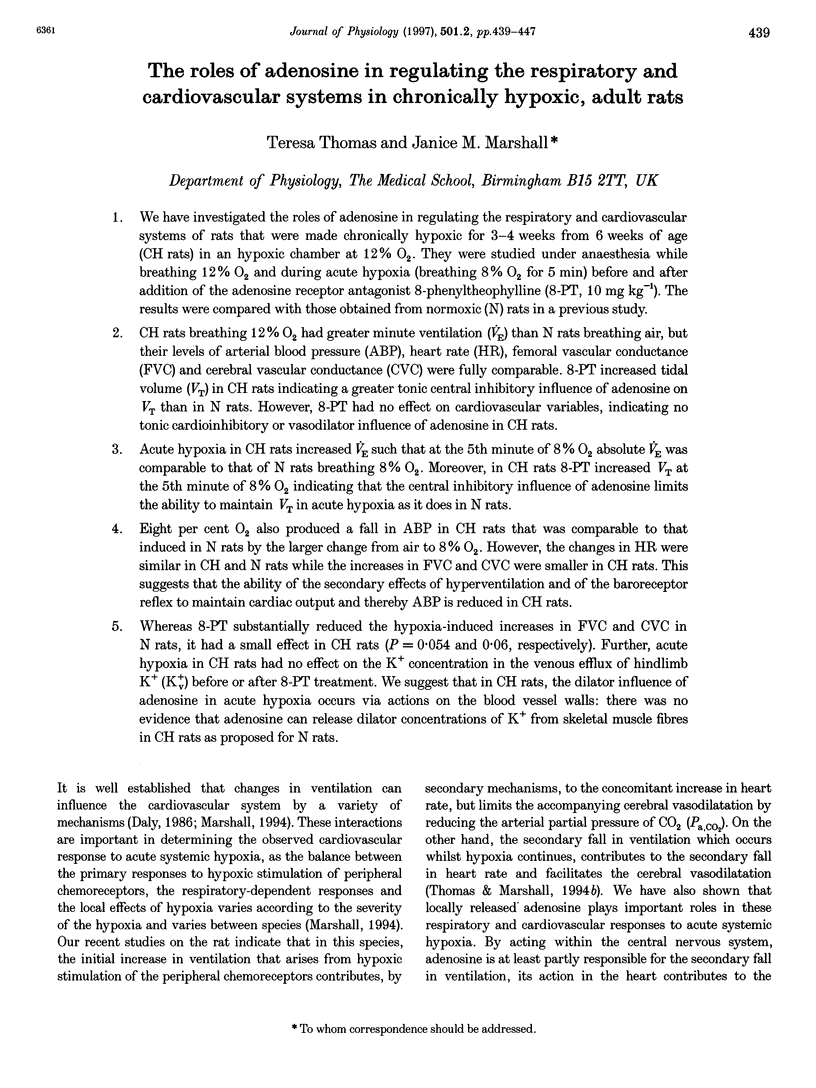
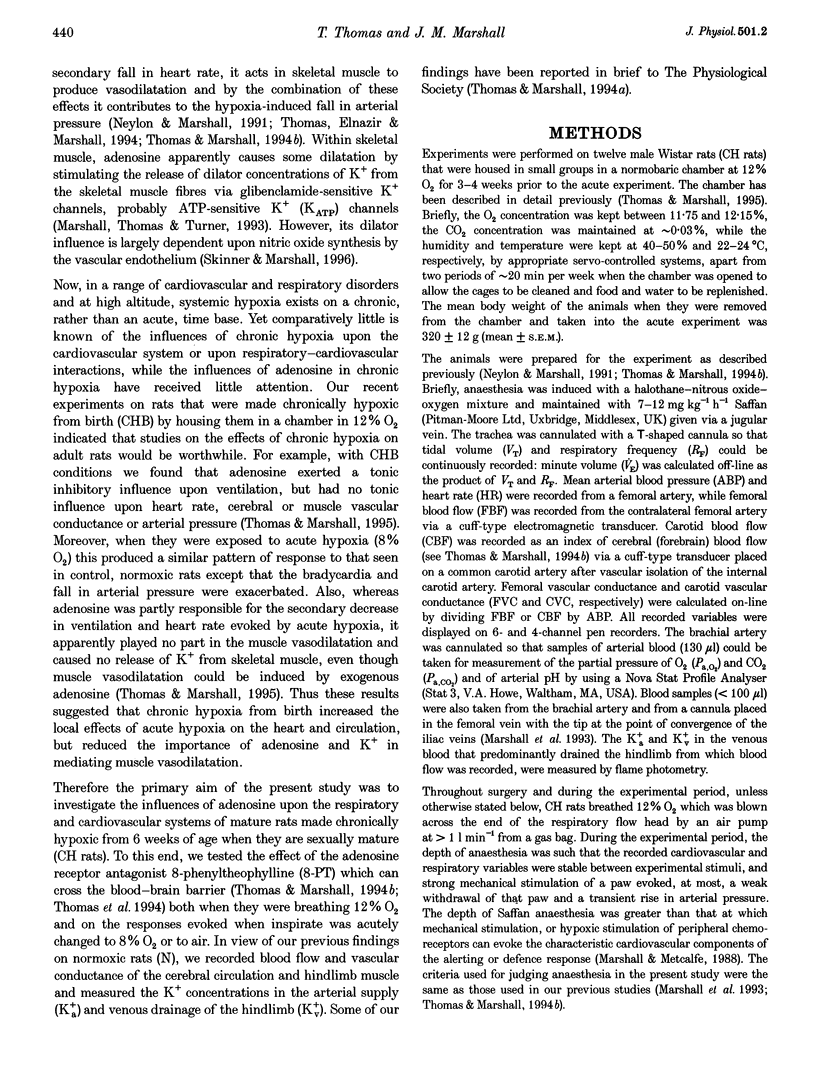
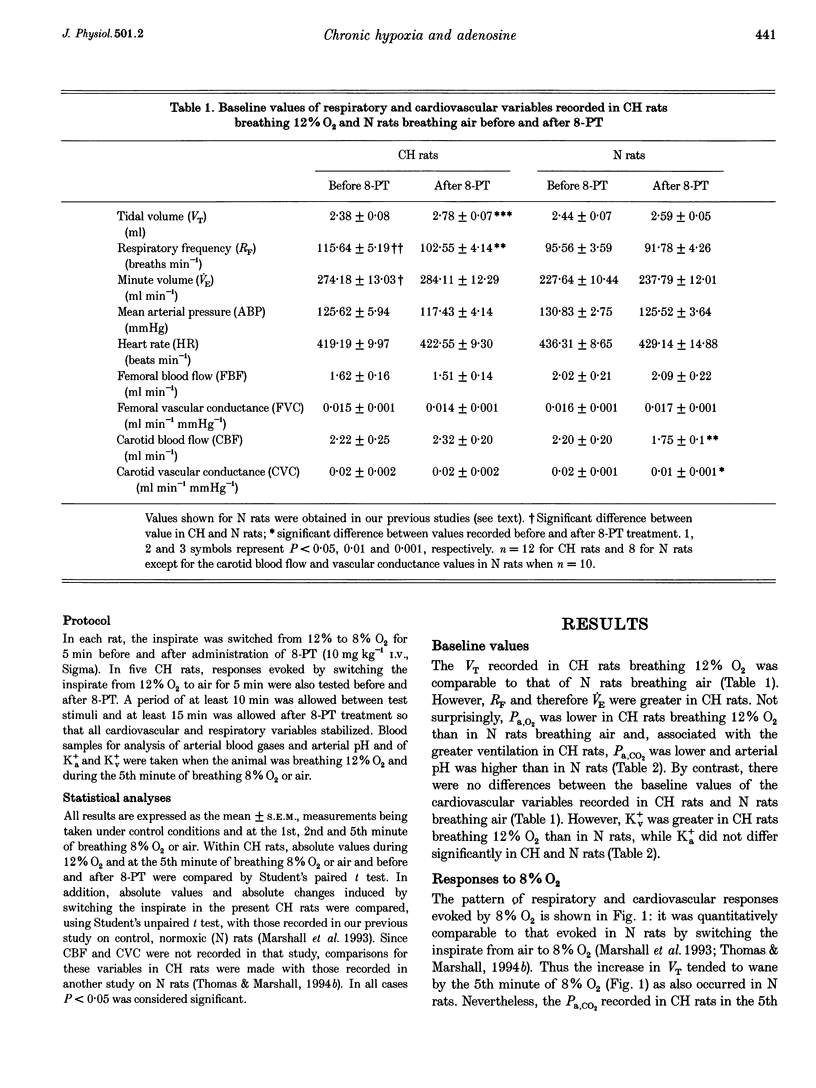


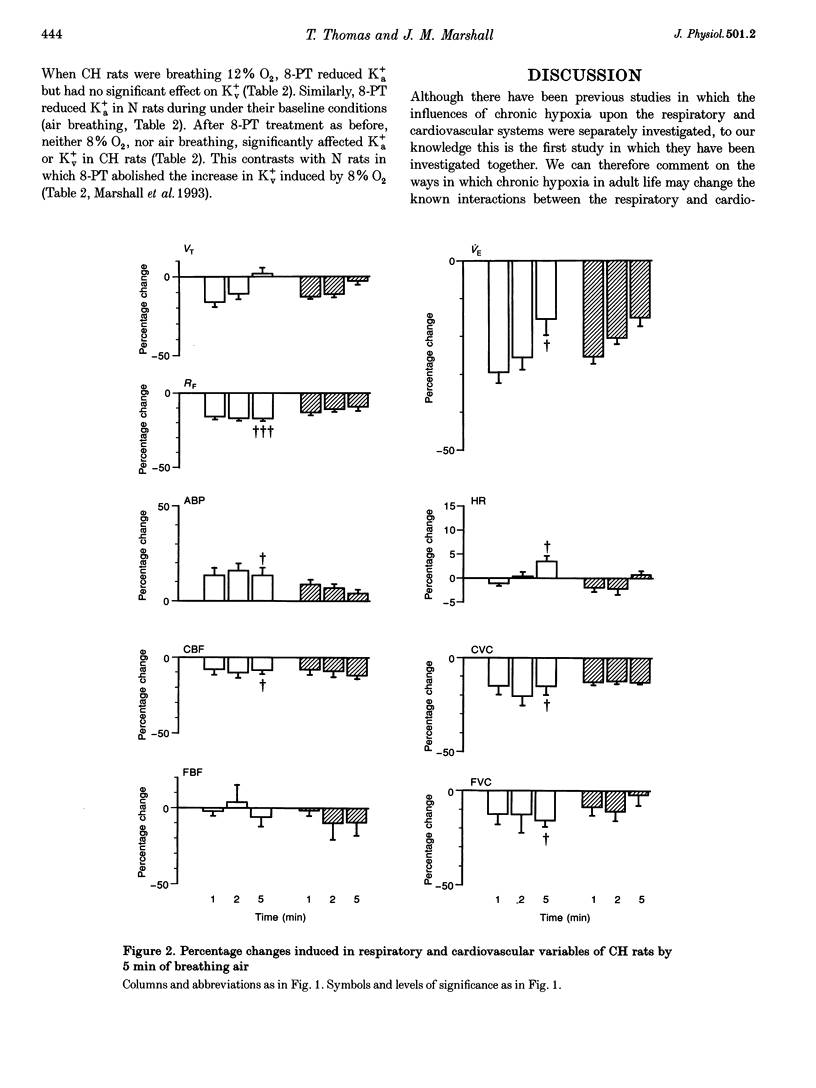
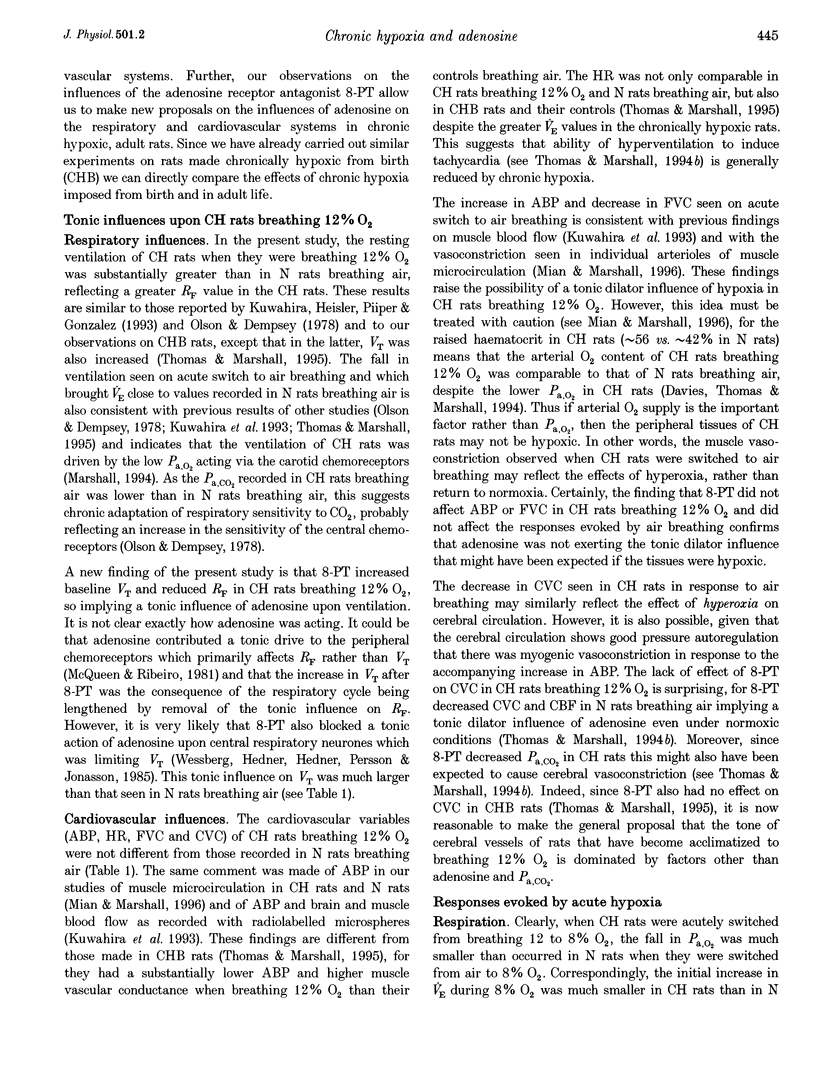
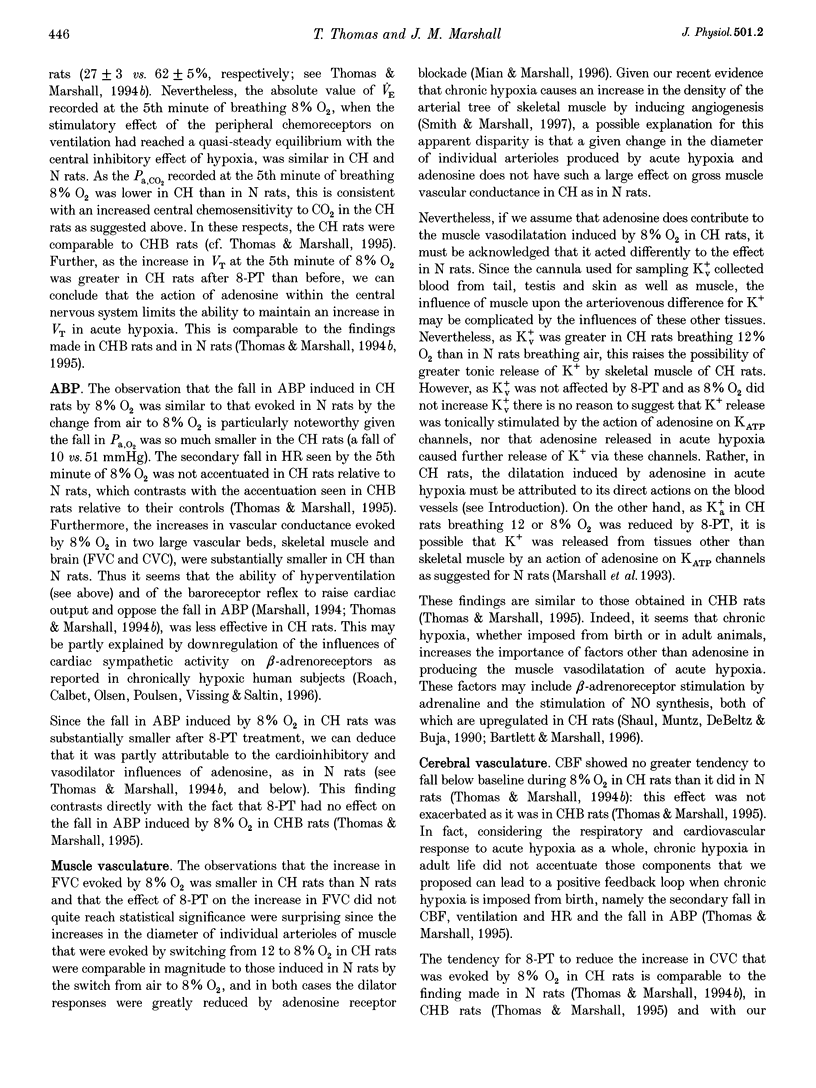
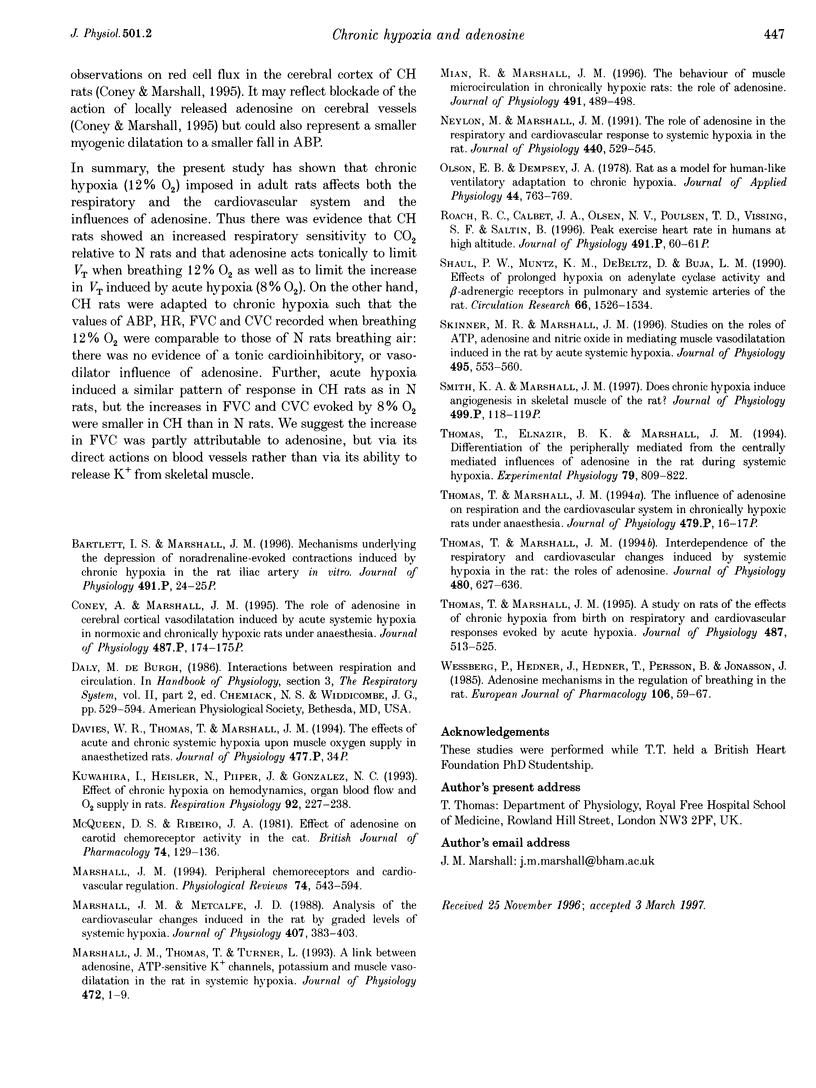
Selected References
These references are in PubMed. This may not be the complete list of references from this article.
- Kuwahira I., Heisler N., Piiper J., Gonzalez N. C. Effect of chronic hypoxia on hemodynamics, organ blood flow and O2 supply in rats. Respir Physiol. 1993 May;92(2):227–238. doi: 10.1016/0034-5687(93)90041-8. [DOI] [PubMed] [Google Scholar]
- Marshall J. M., Metcalfe J. D. Analysis of the cardiovascular changes induced in the rat by graded levels of systemic hypoxia. J Physiol. 1988 Dec;407:385–403. doi: 10.1113/jphysiol.1988.sp017422. [DOI] [PMC free article] [PubMed] [Google Scholar]
- Marshall J. M. Peripheral chemoreceptors and cardiovascular regulation. Physiol Rev. 1994 Jul;74(3):543–594. doi: 10.1152/physrev.1994.74.3.543. [DOI] [PubMed] [Google Scholar]
- Marshall J. M., Thomas T., Turner L. A link between adenosine, ATP-sensitive K+ channels, potassium and muscle vasodilatation in the rat in systemic hypoxia. J Physiol. 1993 Dec;472:1–9. doi: 10.1113/jphysiol.1993.sp019931. [DOI] [PMC free article] [PubMed] [Google Scholar]
- Mian R., Marshall J. M. The behaviour of muscle microcirculation in chronically hypoxic rats: the role of adenosine. J Physiol. 1996 Mar 1;491(Pt 2):489–498. doi: 10.1113/jphysiol.1996.sp021233. [DOI] [PMC free article] [PubMed] [Google Scholar]
- Neylon M., Marshall J. M. The role of adenosine in the respiratory and cardiovascular response to systemic hypoxia in the rat. J Physiol. 1991;440:529–545. doi: 10.1113/jphysiol.1991.sp018723. [DOI] [PMC free article] [PubMed] [Google Scholar]
- Olson E. B., Jr, Dempsey J. A. Rat as a model for humanlike ventilatory adaptation to chronic hypoxia. J Appl Physiol Respir Environ Exerc Physiol. 1978 May;44(5):763–769. doi: 10.1152/jappl.1978.44.5.763. [DOI] [PubMed] [Google Scholar]
- Shaul P. W., Muntz K. H., DeBeltz D., Buja L. M. Effects of prolonged hypoxia on adenylate cyclase activity and beta-adrenergic receptors in pulmonary and systemic arteries of the rat. Circ Res. 1990 Jun;66(6):1526–1534. doi: 10.1161/01.res.66.6.1526. [DOI] [PubMed] [Google Scholar]
- Skinner M. R., Marshall J. M. Studies on the roles of ATP, adenosine and nitric oxide in mediating muscle vasodilatation induced in the rat by acute systemic hypoxia. J Physiol. 1996 Sep 1;495(Pt 2):553–560. doi: 10.1113/jphysiol.1996.sp021615. [DOI] [PMC free article] [PubMed] [Google Scholar]
- Thomas T., Elnazir B. K., Marshall J. M. Differentiation of the peripherally mediated from the centrally mediated influences of adenosine in the rat during systemic hypoxia. Exp Physiol. 1994 Sep;79(5):809–822. doi: 10.1113/expphysiol.1994.sp003809. [DOI] [PubMed] [Google Scholar]
- Thomas T., Marshall J. M. A study on rats of the effects of chronic hypoxia from birth on respiratory and cardiovascular responses evoked by acute hypoxia. J Physiol. 1995 Sep 1;487(Pt 2):513–525. doi: 10.1113/jphysiol.1995.sp020896. [DOI] [PMC free article] [PubMed] [Google Scholar]
- Thomas T., Marshall J. M. Interdependence of respiratory and cardiovascular changes induced by systemic hypoxia in the rat: the roles of adenosine. J Physiol. 1994 Nov 1;480(Pt 3):627–636. doi: 10.1113/jphysiol.1994.sp020389. [DOI] [PMC free article] [PubMed] [Google Scholar]
- Wessberg P., Hedner J., Hedner T., Persson B., Jonason J. Adenosine mechanisms in the regulation of breathing in the rat. Eur J Pharmacol. 1984 Oct 30;106(1):59–67. doi: 10.1016/0014-2999(84)90678-2. [DOI] [PubMed] [Google Scholar]


